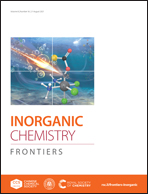White light emission from co-doped La2Hf2O7 nanoparticles with suppressed host → Eu3+ energy transfer via a U6+ co-dopant†
Abstract
Controlled energy transfer has been found to be one of the most effective ways of designing tunable and white photoluminescent phosphors. Utilizing host emission to achieve the same would lead to a new dimension in the design strategy for novel luminescent materials in solid state lighting and display devices. In this work, we have achieved controlled energy transfer by suppressing the host to dopant energy transfer in La2Hf2O7:Eu3+ nanoparticles (NPs) by co-doping with uranium ions. Uranium acts as a barrier between the oxygen vacancies of the La2Hf2O7 host and Eu3+ doping ions to increase their separation and reduce the non-radiative energy transfer between them. Density functional theory (DFT) calculations of defect formation energy showed that the Eu3+ dopant occupies the La3+ site and the uranium ion occupies the Hf4+ site. Co-doping the La2Hf2O7:Eu3+ NPs with uranium ions creates negatively charged lanthanum and hafnium vacancies making the system highly electron rich. Formation of cation vacancies is expected to compensate the excess charge in the U and Eu co-doped La2Hf2O7 NPs suppressing the formation of oxygen vacancies. This work shows how one can utilize the full color gamut in the La2Hf2O7:Eu3+,U6+ NPs with blue, green and red emissions from the host, uranium and europium, respectively, to produce near perfect white light emission.



 Please wait while we load your content...
Please wait while we load your content...
